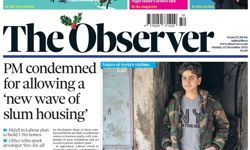Whether you work for a major magazine or publish a niche title, your email results are still only measured the same two ways: as being either a direct response success or a direct response failure. This "either / or" reality of online circulation promotion often reminds me of the American children’s story The Lady or the Tiger.
In that fable, Frank R Stockton writes of a man who, having fallen in love with the king’s daughter, faces the unusual situation of having to choose between opening one of two doors. Behind the first he will find the princess. There will be accolades . . . some storybook kissing . . . and, as its title suggests, a lack of hungry tigers in his path.
While behind the second door — or browser window in your case — lives the prospect of unopened emails . . . underperforming acquisition rates . . . and perhaps a face full of claw marks.
Here are several creative strategies one US publisher is using to pick the right gateway — and to best navigate their online path to increased circulation.
1. Start With The Basics: Offer-Driven Email Promotions
Boston Common Press — the force behind the magazines Cook’s Illustrated and Cook’s Country, as well as television’s America’s Test Kitchen and three subscription websites — is known in the States for their extensive recipe testing. They experiment with ingredients and cooking methods up to 70 times per meal in search of the perfect recipe to pass on to their readers and viewers.
One of their recent email communications tethers the main editorial promise of Cook’s Illustrated magazine to an exclusive online deal: namely, a complimentary trial issue . . . 44% savings off the cover price . . . plus a free grater / zester on payment.
To thematically connect the offer and publication, the premium used is a cooking tool that has been judged by their editors to be the #1 product of its kind. Below an offer-driven headline and succinct body copy, a total of five "Get Free Trial Issue" linkage buttons appear — to hammer home the offer and call-to-action.
While the sales message is formatted as a traditional letter, the benefit list mirrors the effective design of a typical direct mail acquisitions voucher. Given the context of an email, however, the one-to-one correspondence makes for a more natural reading experience.
2. Reflect Web-Based Navigation In Your Email Creative
A similar offer-driven email for Cook’s Illustrated’s sister publication, Cook’s Country, makes even better use of the online environment. Content from the printed magazine is presented to computer users in navigational terms they will find both familiar and attractive.
Eight of the magazine’s key selling points are presented in a clear, colourful fashion, ranging from "Taste Test Results For Supermarket Ingredients" to "Pull-Out Recipe Cards". The continuous length of an email allows for this easy-to-read presentation — which could not have been achieved in a printed package without the high cost of a barrel-fold insert or an oversized letter.
Like tabs on a web page, the magazine spread begs readers to run their cursors over it. As with the earlier email example for Cook’s Illustrated, several red "Get Free Trial Issue" buttons flank either side of the art element to insure a higher click-through rate.
3. Don’t Just Invite Readers To Live Your Editorial Promise — Transport Them
The print magazines published by Boston Common Press each employ a down-home, folksy presentation that celebrates the traditions and values of New England. In this case, those principles are epitomised by thrift . . . Yankee ingenuity . . . and a healthy dose of idealised Americana.
To conjure up and capitalise off this unique editorial positioning, Boston Common Press sends out a series of newsletter-style emails from its founder, Christopher Kimball. The subject heading "Letter from Vermont" segues into a dispatch from Mr Kimball’s bucolic country farm.
Rather than shouting out a directive to subscribe to one of their magazines or TV OnDemand service (a monthly pay service that streams cooking videos from America’s Test Kitchen), this creative presentation takes the long way around.
Slice of life anecdotes share the stories — and covered-bridge-laden photo albums — of this Vermont enclave’s residents. A conversational opening to the letter meanders through the rural backdrop at a leisurely pace; describing a local prankster named Frasier and his attempts to scare off out-of-towners:
"… A new family moved too close to (Frasier’s) place, so one night he tacked a length of violin string to the clapboards of their small house and hid in the bushes, holding the other end. Just after the newcomers went to bed, he pulled out his violin bow and played the string, making an eerie, haunted humming. After three nights, they up and left town."
It takes over two-hundred-words from the "Vermont humour is, at its best, subtle" thesis until the actual sales message kicks in. And while another marketer would be tempted to take her red pen to these lines of pure exposition, the circulation department at Boston Common Press knows that the names on their mailing list don’t just love to dig into a great meal. They also love to read the stories behind them — and long to be transported either through the act of cooking or by reading quality culinary writing. They may even want to be whisked away, for a short time, by an engaging email from the publisher.
4. Lay Out Your Design-Heavy Emails As Though They Were Web Pages
The fourth and final creative tactic in this case study is Boston Common Press’ string of "Notes from the Test Kitchen" email blasts. Giving the reader a behind-the-scenes feel of the two magazines and television show, this presentation straddles the line between entertaining the reader — a la the "Letter from Vermont" communication sited above — and highlighting clear benefits that are immediately linked back to a strong sales message.
This is the only email template the publisher is using that does not follow a letter format. Instead, designed body blocks of text entice the reader down the page with free sample content they can click to access. There is also a printable full recipe of a favourite dish in the body of the email itself.
Living up to its name, these "Notes" do not amble. Rather, the email hits its main points out of the gate via the placement of quick links at top. Not only do those links serve the same intent as the navigational elements of a web page, they also give the reader a chance to have her gratification instantly satisfied by zooming off to complete editorial content at the publisher’s site.
And that’s just for starters.
The email then goes on to sketch out a full, fun menu. A beautiful illustration allows the message to track downward to deliver the reader the best-grilled meal ever. In addition, a bite-size cooking technique — in this case, the easiest method for pitting peaches — leads to several content teases.
Free videos, kitchen advice, and tasting labs all hit the main selling points of Boston Common Press’ products; while at the same time offering a variety of interest points. Driving the recipient to the main website creates added "stickiness" that will give potential subscribers even more reasons and opportunities to place an order.
Let Your Email Creative Live Up To Its Potential!
Remember, while there may only be two ways to gauge online circulation promotion — as belonging either behind the door of victory or the door of defeat — your design formats and sales copy options are only as limited as your imagination.
So, why not take a page from successful US publishers by embracing the internet as a place of innovation . . . and reflecting this understanding in novel email presentations that are inexpensive to test.
All it takes is changing your marketing stripes to reach new readers in a more effective way. And, most importantly, avoiding the tiger — in the shape of emarketing complacency — so you can crown your publication’s online efforts with a truly storybook ending.
FEATURE
Avoiding The Tiger
Some publishers are now putting as much creative energy into their email marketing, as they once did their direct mail. And they are reaping the rewards. Andrew Majewski presents a case study of four email best practices from Boston Common Press, publishers of Cook’s Illustrated.










